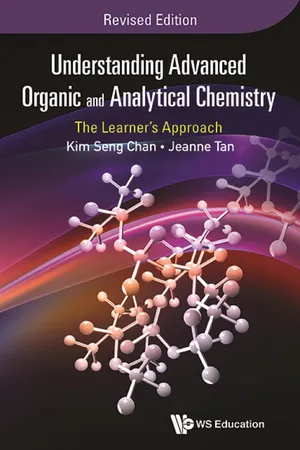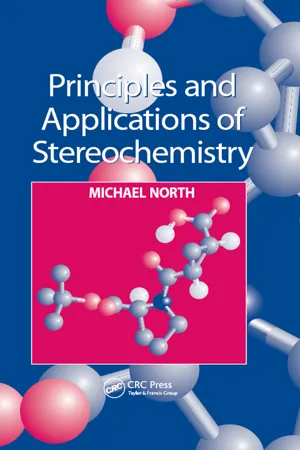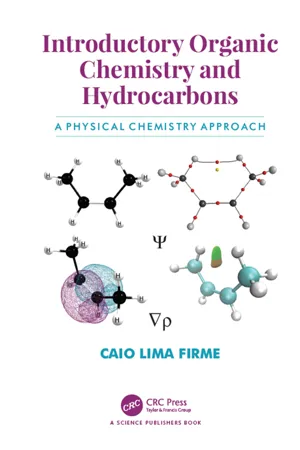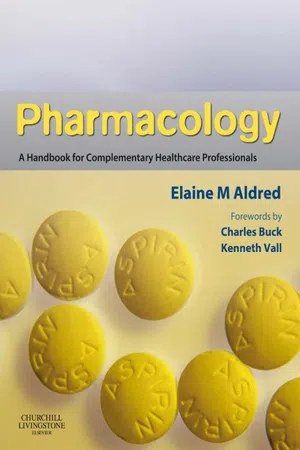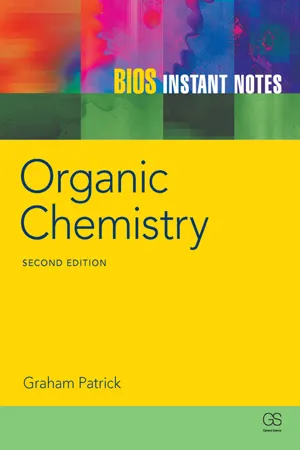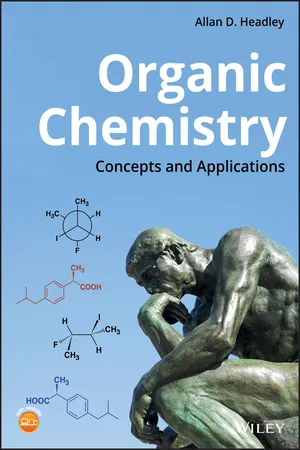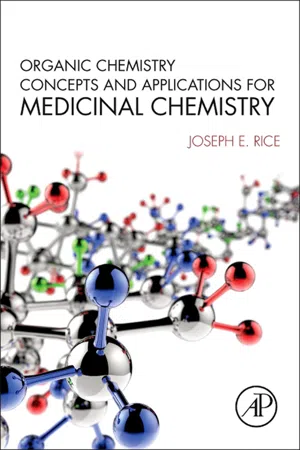Chemistry
Structural Isomerism
Structural isomerism refers to a type of isomerism in which compounds have the same molecular formula but different structural arrangements of atoms. This results in different chemical and physical properties. Examples of structural isomers include chain isomers, position isomers, and functional group isomers.
Written by Perlego with AI-assistance
Related key terms
Related key terms
1 of 4
Related key terms
1 of 3
10 Key excerpts on "Structural Isomerism"
- eBook - ePub
Carbohydrate Chemistry
Fundamentals and Applications
- Raimo Alén(Author)
- 2018(Publication Date)
- WSPC(Publisher)
3. Isomerism
3.1.General
A general molecular formula (e.g., Cx Hy Oz Nn ) expresses the kind and number of the constituent atoms of a compound, but it insufficiently represents the structure of the compound in question. A molecular formula can thus correspond to several compounds (isomers) that normally have different chemical and physical properties. Isomers can be defined as chemical compounds with identical molecular formulas (i.e., contain the same number of atoms of each element) that differ from one another in the arrangements of their atoms. This phenomenon is called “isomerism” (in Greek, “isos” means “equal” and “meros” “part”), and it is divided into two main types (Fig. 3.1 ): (i)constitutional isomerismor Structural Isomerism and (ii)stereoisomerismor space isomerism. Upon examining certain isomers (such as aldoses with the same number of carbon atoms), one does not necessarily find differences based on constitutional isomerism, and finding the actual differences requires detailed comparison of the stereoisomeric properties of the structures.Constitutional isomerism can be divided into three subgroups: (i)functional group isomerism(“function isomerism”), (ii)chain isomerism(“skeletal isomerism”), and (iii)position isomerism(“regioisomerism”), which are discussed in the next chapters with the help of illustrative examples. The general name “Structural Isomerism” is traditionally used for “constitutional isomerism”. However, since the structure of the compounds can be thought to cause all isomerism, the use of the former term is not recommended.Fig. 3.1.The main types of isomerism and their subtypes.The branch of organic chemistry that examines the three-dimensional structures of molecules,stereochemistry, has gained importance when striving to understand the physical and chemical properties of various compounds. In carbohydrate chemistry, it is also essential to know the stereochemical structure of the compounds. Stereoisomerism can be seen to generally represent the form of isomerism where compounds with the same chemical structure (i.e., the order of attachment of the atoms involved and the location of the bonds between them) differ from each other only in the spatial direction of their atoms or atom groups. This isomerism is divided into (i)optical isomerism(“physical isomerism”), (ii)conformational isomerism, and (iii)geometric isomerism(“cis/trans - eBook - ePub
Understanding Advanced Organic and Analytical Chemistry
The Learner's ApproachRevised Edition
- Kim Seng Chan, Jeanne Tan;;;(Authors)
- 2016(Publication Date)
- WS EDUCATION(Publisher)
CHAPTER 2
Isomerism in Organic Compounds
2.1 Introduction
If a molecule has the molecular formula C4 H8 , does it imply that all the C4 H8 molecules are identical? The alkene, but-1-ene, whose molecule is shown below, has the molecular formula C4 H8 .Yet, C4 H8 also represents the formula for cyclobutane, which belongs to the cycloalkane family:Compounds that have the same molecular formula but different structures are known as isomers. This phenomenon is known as isomerism. The two main types of isomerism are constitutional/ Structural Isomerism and stereoisomerism. These are further divided into subclasses of which some are discussed in this chapter. Isomers generally have different physical and chemical properties, but they can also have similar chemical properties if they contain the same functional groups. Each specific functional group possesses a characteristic set of chemical reactions.2.2 Constitutional/Structural Isomerism
Constitutional/structural isomers are compounds with the same molecular formula but different structures or structural formulae. Both but-1-ene and cyclobutane constitute a pair of constitutional/structural isomers. The difference in structures can be attributed to either a difference in the arrangement of atoms or due to the presence of different functional groups.Based on the above definitions, constitutional/Structural Isomerism can be classified into three main types:• chain isomerism;• positional isomerism; and• functional group isomerism.2.2.1 Chain Isomerism
Compounds that exhibit chain isomerism with each other have the same functional group but differ in the way the carbon atoms are connected in the mainskeletal carbon chain of their molecules. In other words, these molecules differ in the degree of branching, hence the term chain isomers - eBook - ePub
- Michael North(Author)
- 2017(Publication Date)
- Routledge(Publisher)
1.5 respectively. In general, these three isomers will undergo the same types of chemical reaction (benzylic oxidation for example), but will do so at different rates, again illustrating their different chemical properties.There is, however, another type of isomerism, one in which all of the atoms in the two isomers do have the same connectivity. A familiar example is found in 1,2-disubstituted alkenes such as compounds 1.6 and 1.7 . In both of these isomeric compounds, the order in which the carbon atoms are joined together is C𝟙–C𝟚=C𝟛–C𝟜 and the only difference between them is that in isomer 1.6 the two methyl groups are on the same side of the double bond, whilst in isomer 1.7 the two methyl groups are on opposite sides of the double bond. Any pair of isomers which have the same connectivity of their atoms but which differ in the relative orientation of those atoms are called stereoisomers.Stereoisomers are the topic of this book and the following chapters will investigate the different structural features which are responsible for stereoisomerism, and discuss the chemical, biological and physical consequences of the formation of stereoisomers. Both organic and inorganic compounds can exhibit stereoisomerism, and examples of each will be found throughout this book. Essentially, stereochemistry is concerned with the shapes of molecules, and the consequences of a molecule adopting a particular shape.Later in this chapter, the way in which the shape of a molecule may be predicted using Valence Shell Electron Pair Repulsion Theory (VSEPR) will be introduced, and the nature of the bonding found in the most common chemical structures will be discussed. At the end of this chapter, the various classifications of stereoisomers will be introduced and these will be discussed in more detail throughout the remainder of this book. However, many of the structures seen later in this chapter are three dimensional, and before they are discussed it is necessary to understand the conventions used when representing three dimensional structures on a two dimensional piece of paper. - eBook - ePub
Chemistry for Pharmacy Students
General, Organic and Natural Product Chemistry
- Lutfun Nahar, Professor Satyajit D. Sarker(Authors)
- 2019(Publication Date)
- Wiley(Publisher)
Louis Pasteur, a well‐known French biologist, chemist, and microbiologist, is the first stereochemist, who observed that salts of tartaric acid collected from wine production vessels could rotate plane polarized light, but that salts from other sources did not; this observation was made in 1849. Before we go into further details, let us have a look at different types of isomerism that may exist in organic molecules.3.2 ISOMERISM
Compounds with the same molecular formula but different structures are called isomers. For example, 1‐butene and 2‐butene have the same molecular formula, C4 H8 , but structurally they are different because of the different position of the double bond. There are two types of isomers: constitutional isomers and stereoisomers.3.2.1 Constitutional Isomers
When two different compounds have the same formula but different connections between atoms, they are called constitutional isomers. To determine whether two molecules are constitutional isomers, simply count the number of each atom in both molecules and see how the atoms are arranged. If both molecules possess the same count for all of the different atoms, and the atoms are arranged in different ways, the molecules will be considered as constitutional isomers. For example, ethanol and dimethylether have the same molecular formula, C2 H6 O, but they differ in the sequence of bonding. Similarly, butane and isobutane are two constitutional isomers. Constitutional isomers generally have different physical and chemical properties.3.2.2 Stereoisomers
Stereoisomers are compounds that have the same molecular formula and the same connection between atoms, but differ in the arrangement of atoms in the space, that is, in three dimensions (3D). For example, in α‐glucose and β‐glucose, the atoms are connected in the same order, but the 3D orientation of the hydroxyl group at C‐1 is different in each case. Similarly, cis‐ and trans‐cinnamic acid only differ in the three dimensional orientation of the atoms or groups.There are two major types of stereoisomers: conformational isomers and configurational isomers - eBook - ePub
Introductory Organic Chemistry and Hydrocarbons
A Physical Chemistry Approach
- Caio Lima Firme(Author)
- 2019(Publication Date)
- CRC Press(Publisher)
Chapter ThirteenIsomerism
ISOMERISM AND TYPES OF ISOMERISM
Isomerism gives rise to isomers that are molecules with the same chemical formula but different structural parameters or different spacial structures (different type of branching or different type of functional group or different position of the same functional group or different arrangement of substituents or different absolute configuration of the asymmetric atom).As for Structural Isomerism, there are three types: chain isomerism, position isomerism (or regioisomerism), and functional isomerism.The chain isomerism is related to the different position of the branching in its main chain. For example, butane and 2-methyl-propane are isomers (C4 H10 ); pentane, 2-methyl-butane and 2,2-dimethyl-propane are isomers (C5 H12 ); but-1-ene and 2-methyl propene are isomers (C4 H8 ) as well (see Fig. 13.1(A) ).Figure 13.1 Bond line formula of (A) chain isomers, (B) regioisomers, and (C) functional isomers.The position isomerism (or regioisomerism) is related to a different position of the substituent group or functional group in the molecule. For example, but-1-ene and but-2-ene are isomers (C4 H8 ), pentan-2-one and pentan-3-one are isomers (C5 H10 O), 2-chloro-propane and 1-chloro-propane are isomers (C3 H7 Cl), orto-dichlorobenzene and para-dichlorobenzene are isomers (C6 H4 Cl2 ) as well (see Fig. 13.1(B) ).Functional isomerism is related to different functional groups with the same molecular formula. For example, propanone and propanal are isomers (C3 H6 O), hexan-1-ene and cyclohexane (C6 H12 ) are isomers as well (see Fig. 13.1(C) ).Stereoisomerism is related to specific arrangements of substituents where two isomers are differentiated by their spacial disposition. Stereo means spacial.GEOMETRIC STEREOISOMERISM
Geometric stereoisomerm occurs in alkenes or derivatives and in substituted cycloalkanes. They generate two isomers called cis and trans or E and Z. - eBook - ePub
Pharmacology
A Handbook for Complementary Healthcare Professionals
- Elaine Mary Aldred(Author)
- 2008(Publication Date)
- Churchill Livingstone(Publisher)
Figure 6.2(i) ) occur because functional groups can branch off from the main carbon backbone. The number of carbon and hydrogen atoms remains the same but the structures are very different.Figure 6.2 The different forms of Structural Isomerism. (i) Chain (ii) positional (iii) mixture of chain and positional.Positional Isomerism
In positional isomers (Figure 6.2(ii) ) the structure of the carbon backbone remains the same but the functional groups or side chains are moved around the backbone.Combinations
It is possible to have a mixture of chain and positional isomerism (Figure 6.2(iii) ). Positional isomerism can occur around an aromatic ring (see Figure 5.3 , p. 31 ), hence the need for precise nomenclature.Stereoisomers
It is at this point that thinking in three dimensions becomes important. Stereoisomers are isomers whose components are connected around the same point, but whose arrangement in space is different.Entaniomers
Enantiomers are stereoisomers that are mirror images of each other and all thecomponents of the compound radiating from one point are different. The term forthis is chiral . The position of the compound around which this occurs is a chiral centre (see Figures 6.3 , and Figures 6.7 ). Take, for example, natural alanine, which is foundin only one isomeric form: L -alanine ( Figures 6.3 ). If alanine is produced synthetically, then both forms L and D alanine, are found. This is signifi cant when it comes togiving a patient nutritional supplementation, as the L isomer is more likely to fit intothe receptor site of an enzyme, which explains why natural products are favoured innutritional supplementation.Figure 6.3 The two isomers of alanine.• What exactly do D and L mean?
Light normally vibrates in all directions, but if put through a polarizer it will vibrate in only one direction (Figure 6.4(i) ). If another polarizer is placed at exactly 90°, no light will get through. You can test this yourself with two pairs of good-quality sunglasses. Line them up, and then turn one through 90°. The lens will appear black because no light is getting through (Figure 6.4 (ii) - eBook - ePub
- Graham Patrick(Author)
- 2004(Publication Date)
- Taylor & Francis(Publisher)
SECTION D — STEREOCHEMISTRYD1 Constitutional isomers
Key Notes
Introduction Isomers are compounds which have the same molecular formula, but differ in the way the atoms are arranged. There are three types of isomers — constitutional, configurational, and conformational. Definition Constitutional isomers are compounds which have the same molecular formula but have the atoms joined together in a different way. Constitutional isomers have different physical and chemical properties. Alkanes Alkanes of a particular molecular formula can have various constitutional isomers. The larger the alkane, the more isomers are possible. Related topics (B3) Nomenclature (C5) Nomenclature of functional groups (D2) Configurational isomers -alkenes and cycloalkanes (D3) Configurational isomers -optical isomers (D4) Conformational isomers Introduction
Isomers are compounds which have the same molecular formula (i.e. they have the same atoms), but differ in the way these atoms are arranged. There are three types of isomers — constitutional isomers, configurational isomers, and conformational isomers. Constitutional isomers are isomers where the atoms are linked together in a different skeletal framework and are different compounds. Configurational isomers are structures having the same atoms and bonds, but which have different geometrical shapes that cannot be interconverted without breaking covalent bonds. Configurational isomers can be separated and have different properties. Conformational isomers are different shapes of the same molecule and cannot be separated.Definition
Constitutional isomers are compounds which have the same molecular formula but have the atoms joined together in a different way. In other words, they have different carbon skeletons. Constitutional isomers have different physical and chemical properties.Alkanes
Alkanes of a particular molecular formula can exist as different constitutional isomers. For example, the alkane having the molecular formula C4 H10 can exist as two constitutional isomers — the straight chain alkane (butane) or the branched alkane (2-methylpropane; Figure 1 - eBook - ePub
Organic Chemistry
Concepts and Applications
- Allan D. Headley(Author)
- 2019(Publication Date)
- Wiley(Publisher)
5 Stereochemistry 5.1 Introduction In a three‐dimensional world, our analysis of atoms and molecules must be from that perspective. In this chapter, a detailed examination of the three‐dimensional arrangement of atoms in a molecule will be carried out. The study of differences in isomers brought about by differences in location of atoms or groups in molecules in three‐dimensional space is called stereochemistry. Geometric and conformational stereoisomers have already been examined in the previous chapter. Geometric isomers differ from each other based on the arrangement of the atoms or groups across a rigid plane, such as a double bond or rigid cyclic ring in the molecule. For example, trans ‐1,2‐dichloroethene is different from cis ‐1,2‐dichloroethene since the chlorine atoms are on different sides of the rigid double bond. On the other hand, conformational isomers differ from each in that groups or atoms in the molecule are in different locations due to rotation about a single bond, typically a carbon–carbon single bond. Thus, the anti‐conformer of 1,2‐dichloroethane is different from the gauche conformer. These conformers are different only in the spatial arrangement of the groups around the carbon–carbon bond; and as a result, their relative energies are different. For some stereoisomers, it is extremely difficult to visualize differences that result in three‐dimensional space for molecules brought about by different spatial arrangements of the atoms or groups, unless a model set is used. Stereochemistry is the study of molecules that have the same atom–atom connectivity, but the spatial arrangement among the groups or atoms is different, resulting in different molecules, known as stereoisomers. Just as a pair of shoes looks similar, but the spatial arrangements in three‐dimensional space are different. Try putting on the left foot of the shoe on your right foot, it just will not fit since it is different from the right foot of a pair of shoes - Joseph E. Rice(Author)
- 2014(Publication Date)
- Academic Press(Publisher)
Chapter 2The Three-Dimensional Structure of Organic Compounds
Abstract
This chapter opens with a discussion of the various types of isomers leading into a more detailed look at stereoisomerism. The concept of optical isomers at saturated asymmetric centers is then introduced along with a discussion of the properties of enantiomers and the methods used to designate absolute configuration at such stereocenters. Diastereomers are then discussed as being stereoisomers that are not enantiomers. The idea of prochirality is introduced and examples of saturated prochiral centers and unsaturated prochiral faces are given. Stereoisomerism at unsaturated centers is then discussed along with a system to designate those isomers. The last section deals with conformations, beginning first with acyclic systems and then progressing to cyclohexanes, and finally to five-, four-, and three-membered saturated rings.Keywords
Absolute configuration ; Chiral center ; Conformation ; Diastereomer ; Dihedral angle ; Eclipsed ; Enantiomer ; Isomer ; Nonbonded interactions ; ProchiralOne of the critical factors associated with drug–receptor interactions is the three-dimensional structure of both the drug and receptor molecules. Efficient interaction between a drug and its receptor depends not only on the absolute and relative positioning of groups in space but also on the ability of the molecule to modify its shape by rotating about single bonds. These aspects of chemical structure are known as stereochemistry and conformation and are the topics covered in this chapter.Isomers
Two or more compounds that have the same empirical formula but differ with respect to how the various atoms are joined are called isomers . Isomers are broken down into two broad categories. The first is constitutional isomers —compounds that differ in constitution or make-up. Thus cyclopropane and propylene (Figure 2.1 ) are constitutional isomers because cyclopropane is composed of three CH2 (methylene) groups arranged into a three-membered ring, whereas propylene is acyclic with a vinyl and a methyl group. The alcohols n -propanol and i -propanol are also constitutional isomers that are similar chemically but differ in the position to which the hydroxyl group is attached (also called positional isomers ). Thus n -propanol has the hydroxyl group attached to methylene with an ethyl group attached to the same carbon. In contrast, i -propanol has the OH group attached to a CH (methine) that is also attached to two methyl groups. Another example of this is seen with isobutylene and cis - or trans -2-butene. Isobutylene has one sp2 -hybridized carbon with two methyl groups and another one with two hydrogen atoms attached, whereas cis - and trans -2-butene have two sp2 carbons each with one methyl group and one hydrogen atom. Thus, isobutylene and cis - or trans -2-butene are constitutional isomers. But what is the relationship between cis - and trans -2-butene? Since they have the same constitution but differ in the special arrangement of the various groups, they are called stereoisomers- eBook - ePub
- John Wright(Author)
- 2004(Publication Date)
- Routledge(Publisher)
trans.- A chiral centre is one containing an asymmetric carbon atom and gives rise to stereoisomerism called optical isomerism. Optical isomers are optically active.
- Optically active chemicals can rotate the plane of polarised light. Optical isomers are non-superimposable on each other. By convention (+) isomers rotate the plane of polarised light clockwise, and (-) isomers rotate it to the left.
- Organic molecules can undergo a range of chemical reactions according to the functional groups present, e.g. oxidation, reduction, addition, condensation, hydrolysis and substitution reactions.
Questions
- From the pairs of molecules listed below, which
- (a) belong to the same homologous series
- (b) are position isomers
- (c) are functional isomers
- (d) are skeletal isomers
- (e) are identical molecules
- (f ) are none of the above.
- (i) CH3 CH2 CH2 OH
- (ii) CH3 CHOHCH3
- (iii) CH3 CHOHCH3
- (iv) (CH3 )2 CHOH
- (v) CH3 OCH3
- (vi) CH3 CH2 OH
- (vii) (CH3 )2 CHCH3
- (viii) CH3 CH2 CH2 CH3
- (ix) CH3 CH2 CH2 OH
- (x) CH3 OCH3
- (xi)(CH3 )2 CHCH2 Br
- (xii)CH3 CH2 CHCH3 CH2 Br
- An organic material, containing one carbon–carbon double bond has the molecular formula C3 H5 Cl. Draw all the possible structural formulae.
- Using the compound from (2) above, identify the one compound that can exhibit geometric isomerism.
- An ester, X, has the molecular formula C4 H6 O2 . It is suspected to have one carbon–carbon double bond in its structure.
- (a) Suggest a test that could be used to show that this compound contains a carbon–carbon double bond.
- (b) There are five possible structures for ester X. One of these structures exists as a pair of geometric isomers. Draw the five structures, showing which one exists as a pair of geometric isomers.
- (c) If the five possible esters are hydrolysed, what five alcohols will be formed? Which pair of alcohols shows positional isomerism?
Index pages curate the most relevant extracts from our library of academic textbooks. They’ve been created using an in-house natural language model (NLM), each adding context and meaning to key research topics.
Explore more topic indexes
Explore more topic indexes
1 of 6
Explore more topic indexes
1 of 4

